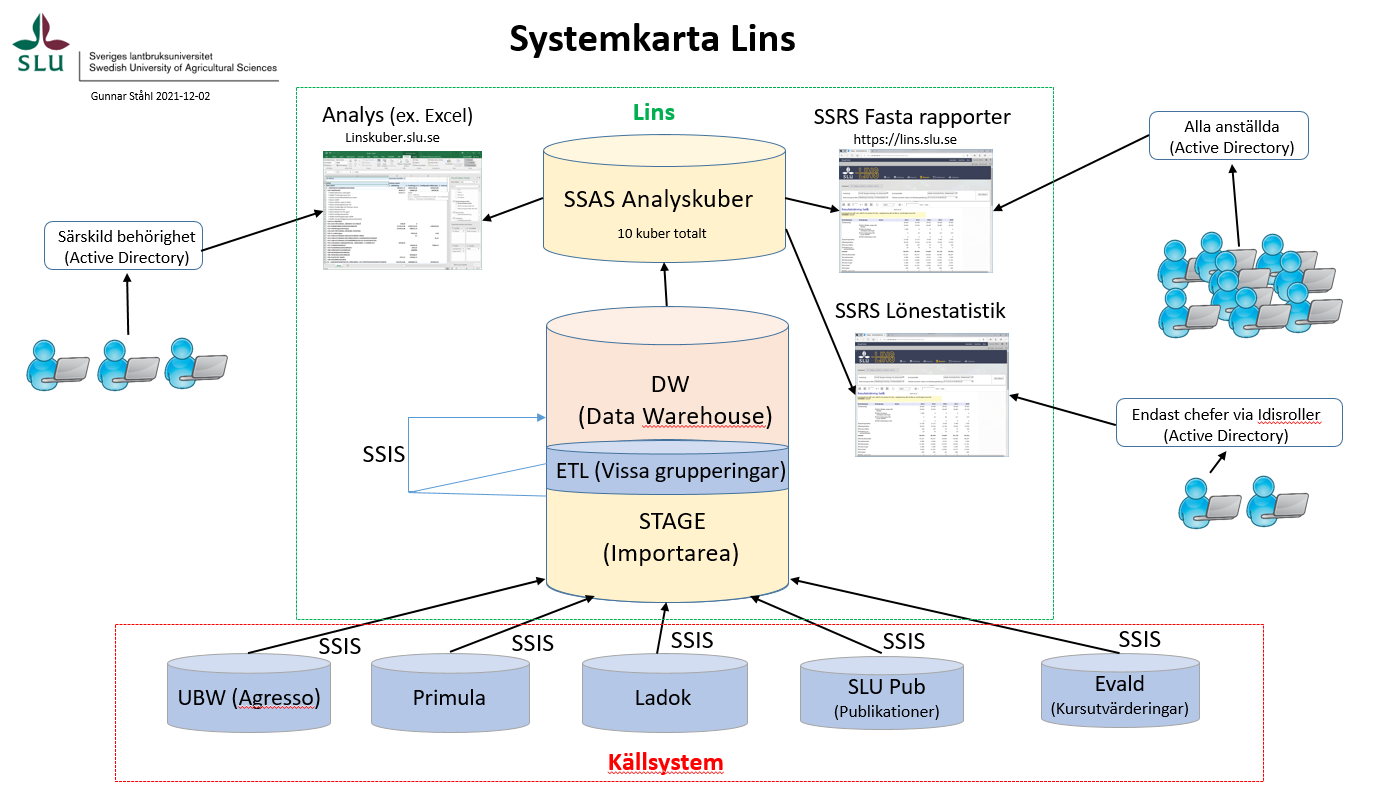Contact
Visit our Contact page to find contact information for the Software Development and Maintenance unit.

LINS is SLU’s leadership information system. An operational follow-up system providing decision support to those working with the planning and management of SLU operations. These include the university’s leadership, prefects, controllers and administrative staff across all departments and institutions.
LINS is primarily a data warehouse regularly pooling data from several of SLU’s other key IT systems:
The collective data store is made available via advanced SSAS analysis cubes and as a whole host of business relevant follow-up reports. Access to reports is provided through a dedicated web portal. Access eligibility is controlled in Active Directory with role administration in IDIS.
Staff use cube analysis and reports to follow up on their operations and as data support when making various decisions. It is therefore important to have actual and correct information available when making such planning decisions.
LINS is developed using Microsoft’s standard tools for Business Intelligence (BI).

LINS data warehouse uses Microsoft SQL Server in SLU’s shared database environment.
ETLs deployed to a shared SLU SSIS resource.
Approximately ten analysis cubes hosted in a shared SLU SSAS resource. Available for direct connection and as a source to LINS reports.
A shared SLU SSRS report server.
The Sharepoint site lins.slu.se as a web portal.
LINS is developed using Microsoft Business Intelligence.
The LINS data warehouse consists of Microsoft SQL Server databases for the data store, staging, configurations and logging.
ETLs for staging and loading are developed with SQL Server Integration Services (SSIS). The originating data sources are on various different platforms both internal and external to SLU. Integration strategies vary therefore too. The publications database for example is hosted in Germany, and extraction is loaded first to an intermediate database at SLU before LINS. The personnel database as another example is an external Oracle source to which an OLE DB connection is used.
SQL Server Analysis Services (SSAS) is used to generate and to process approximately ten analysis cubes covering different usage cases such as examinations, economy, publications etc.
SQL Server Reporting Services (SSRS) is used for reports.
Lins.slu.se is a dedicated web portal developed as a Sharepoint site.
The full load of LINS is performed daily and is managed by coordinated and scheduled jobs in SQL Server Agent.
Access to analysis cubes and reports is controlled by roles and groups in Active Directory. All employees are eligible for certain reports while the cubes and reports that require higher privileges are administered through role and approval processes in IDIS.
The Division of Planning are the system owner of LINS.
LINS was first developed 2009/2010 in an agile system development project by the IT Department in cooperation with the Division of Planning.
To successfully develope a project of this nature, a very close cooperation with the client side is imperative as it is they who have the necessary domain knowledge.
LINS went live in 2011 covering economy, personnel and educational follow-up. Support for publications follow-up and course evaluation have since been developed and added to the system.
LINS is part of the common maintenance object ‘FO Verksamhetsstöd’. It has a maintenance organisation with monthly meetings and comprising of maintenance leaders and system engineers from the IT Department as well as client representatives from the Division of Planning. The team are responsible for case management, life cycle planning and the initiation of further development projects when required.
At the initiative of the maintenance leader, meetings including representatives for each of LINS’ various source systems are held twice a year.
LINS data warehouse contains approximately 63 million rows of data from its source systems spanning from today back to 2005, which are aggregated to analysis cubes and reports.
Information from LINS is used to support the university’s annual report. In a time before LINS, collating data from several source systems for this was a manual task and very time consuming.
A major benefit for LINS users is that they can visit a single system instead of five and can access the data they require in a single standardised way.
Visit our Contact page to find contact information for the Software Development and Maintenance unit.
The LINS portal on SLU’s staff web. (Site in Swedish only!)